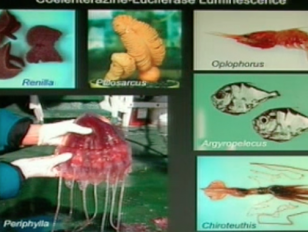Chemistry of Bioluminescence

Presenter: Osamu Shimomura
Published: July 2014
Age: 18-22 and upwards
Views: 1558 views
Tags: bioluminescence;luminescence;photoprotein
Type: Lectures
Source/institution: Lindau-Nobel
Watch now
There are numerous kinds of luminous organism on earth. Mysterious emission of light from them inspired the curiosity of mankind ever since the ancient times. In history, Raphael Dubois discovered luciferin and luciferase from one of them, a click beetle, in 1885. Then, the chemical secret of some of the bioluminescent organisms began to be uncovered in the 1940s. In the following half a century, the chemical structures of 9 different luciferins were determined and the mechanisms of their light-emitting reactions were elucidated at least in part. In our present knowledge, bioluminescence reactions can be divided into 3 types: luciferin-luciferase type, photoprotein type, and the others. The luciferin-luciferase type includes the bioluminescence reactions of the firefly, luminous bacteria, the ostracod Cypridina, coelenterazine, fresh water limpet Latia, earthworm, krill, dinoflagellates, and the Bermuda fire worm Odontosyllis. The photoprotein type includes the bioluminescence reactions of various coelenterates (Aequorea, Obelia, mitrocoma, etc), ctenophores, the tubeworm Chaetopterus, the scale worms, the clam Pholas, the squid Symplectoteuthis, and the millipede Luminodesmus. As to _the others”, only one kind of bioluminescence system is presently known: the luminous fungi. Today, some of the bioluminescence reactions are used as indispensable analytical tools in various fields of science: for example, the firefly luminescence reaction for measuring ATP; Ca2+-sensitive photoproteins for monitoring the intracellular Ca2+; certain analogues of Cypridina luciferin for measuring superoxide anion; and the green fluorescent protein (GFP) as a marker protein in the field of biomedical research.



